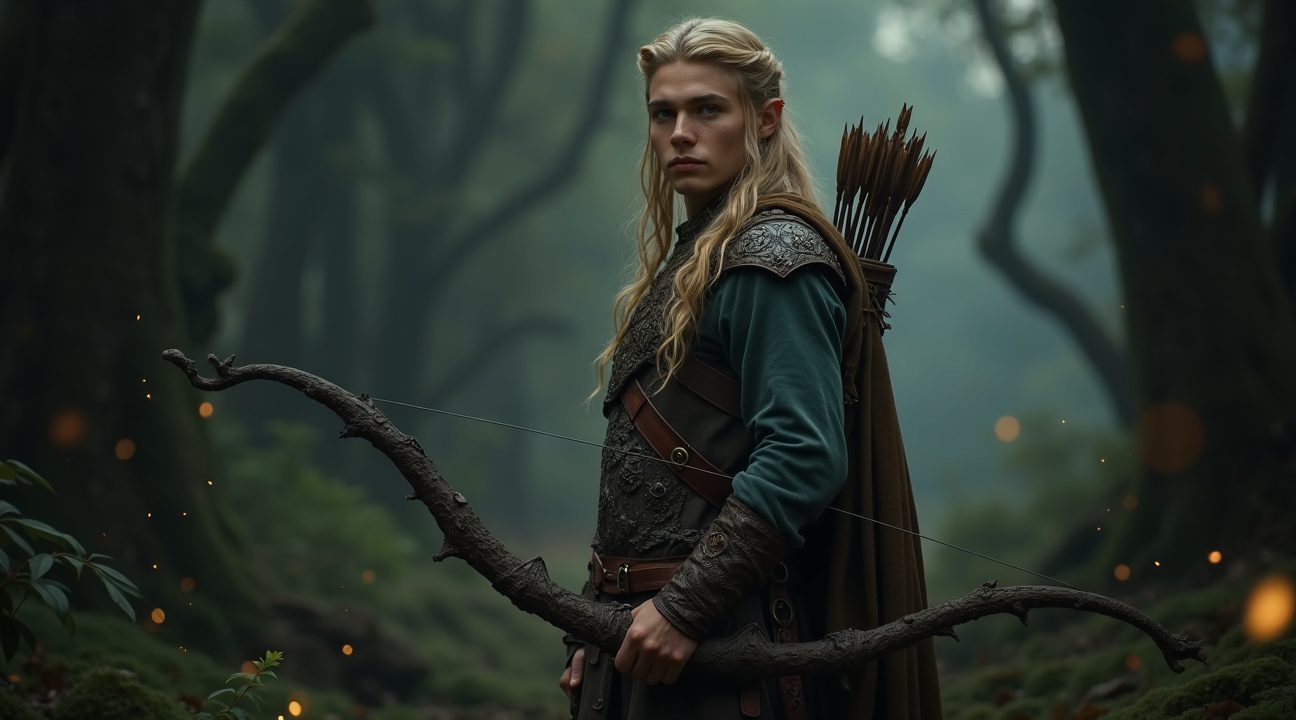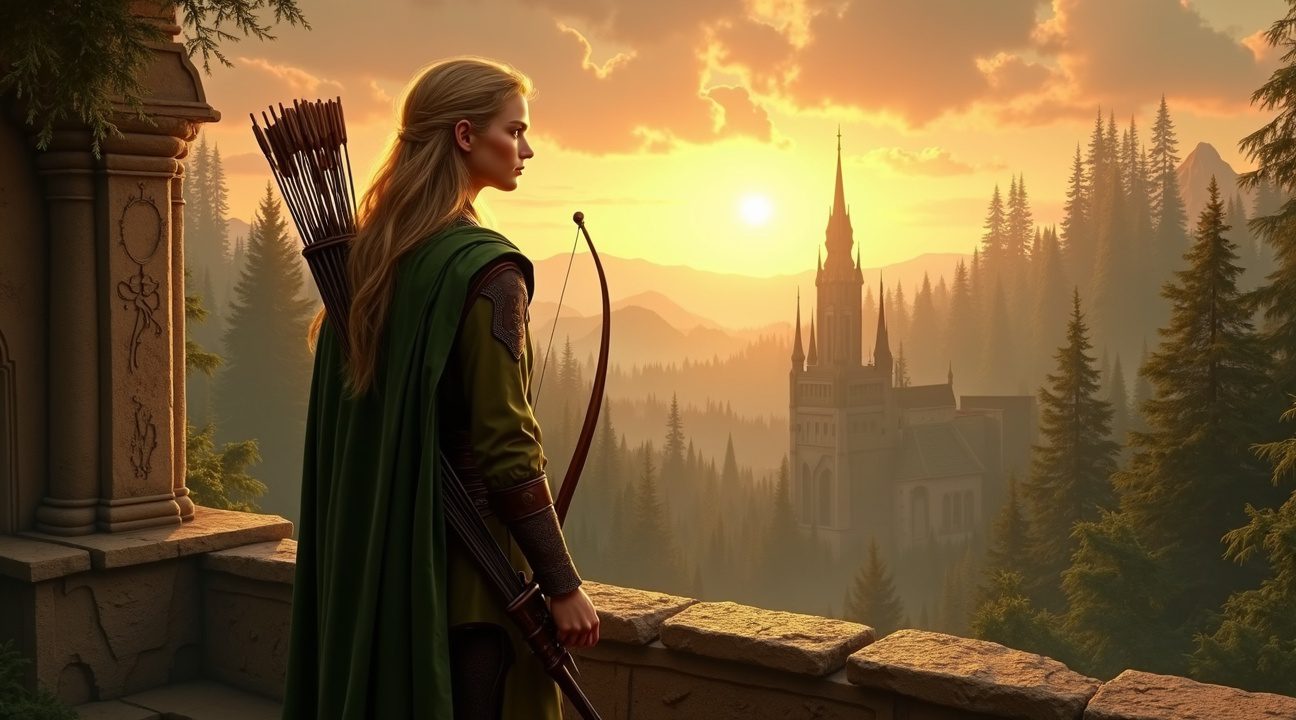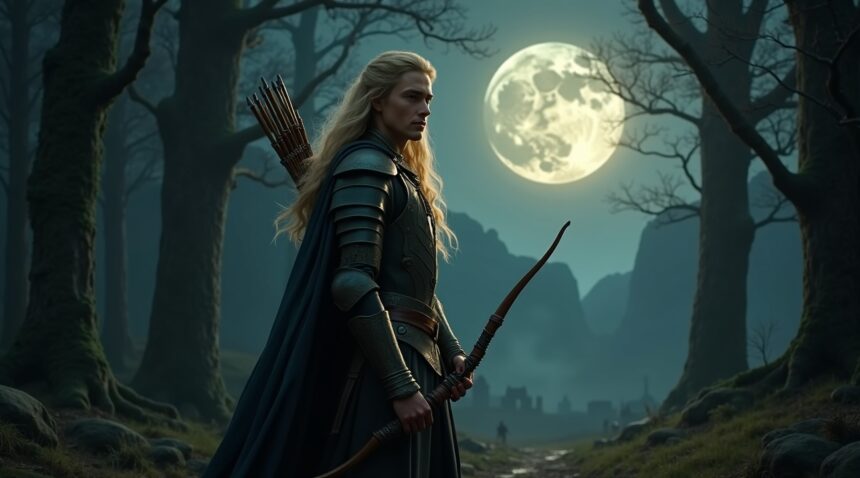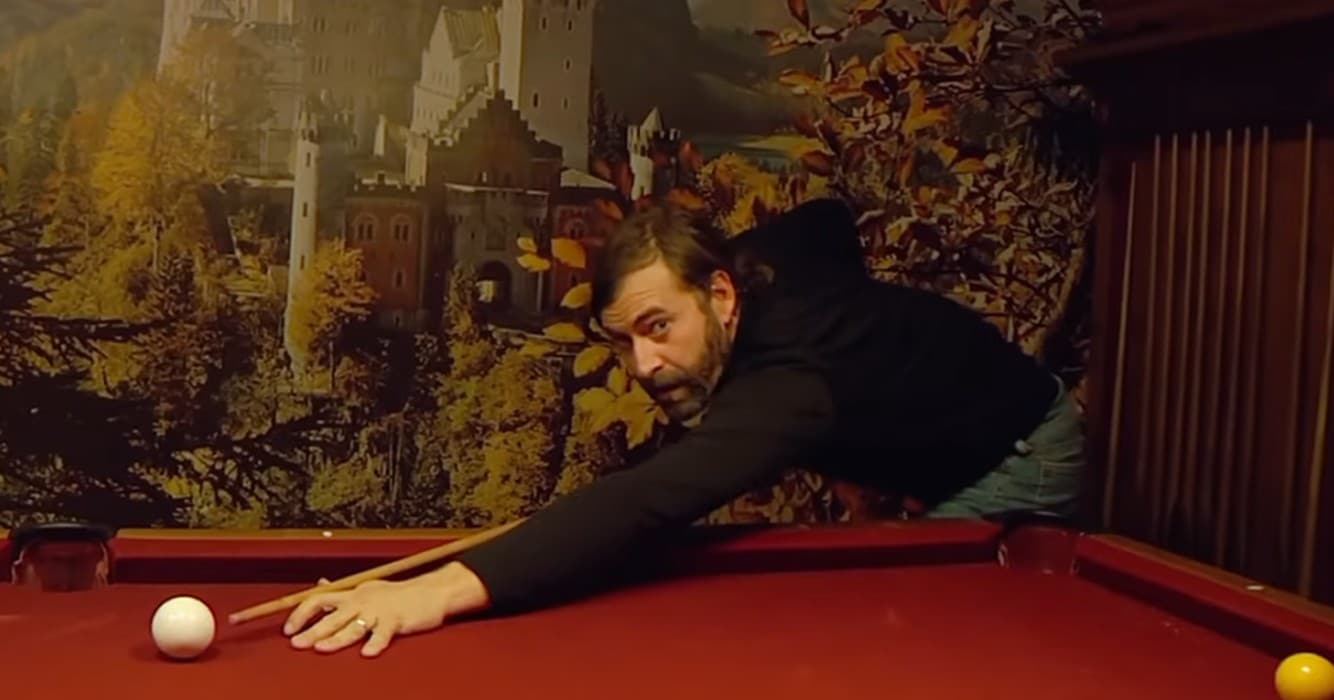Orlando Bloom’s Fierce Affection for Legolas and Franchise Loyalty
Orlando Bloom has openly expressed a deep, emotional connection to his iconic role as Legolas in the Lord of the Rings franchise, declaring he would “hate to see anyone else” take up the bow and arrow in future projects.
A Hero Who Won’t Let Go of His Bow
At 48, Orlando Bloom recognizes that reprising Legolas would require AI de-aging to maintain the character’s immortal youth. Nonetheless, he remains passionate and protective of the role that helped catapult him to fame in Peter Jackson’s legendary trilogies. This connect-the-dots relationship between actor and character represents a broader industry trend where iconic portrayals become inextricably linked to the original performer.
Key Takeaways
- Orlando Bloom said he would strongly prefer that no one else ever plays Legolas and is open to returning to the role if approached.
- AI-driven de-aging technology would be essential for Bloom to convincingly play the age-defying elf at this point in his life.
- His inclusion in the upcoming film “The Hunt for Gollum”, slated for December 2027, depends on whether the script offers a meaningful place for Legolas.
- Bloom displays a similar protectiveness over Will Turner, his character in Pirates of the Caribbean, showing a consistent attachment to his major roles.
- Hollywood faces challenges when fans and performers alike form deep connections with iconic roles, making recasting or continuation decisions difficult for studios.
Technology and Storytelling: A Delicate Balance
Studios like Warner Bros. now have access to AI de-aging techniques that could make Bloom’s return as Legolas visually plausible. Recent projects using this tech — such as in Marvel and Star Wars franchises — suggest it’s possible to create a seamless illusion of youth. However, such decisions entail hefty production costs and ethical debates about reliance on digital recreations of age or even deceased characters.
A Role That Changed His Life
Legolas wasn’t just another part—it was the role that propelled Bloom, along with many of his co-stars, into global prominence. His bond to the character is both personal and professional. The idea of recasting Legolas might make practical sense to some, but for Bloom—and many fans—it would feel like losing a friend to someone else.
“The Hunt for Gollum”: A Question of Fit
The upcoming film “The Hunt for Gollum” focuses on the enigmatic character of Gollum. Whether there’s a place for Legolas in the narrative remains uncertain. Writers and producers must weigh story integrity against fan desire for returning favorites — and Bloom’s availability and willingness to return offer an enticing, yet potentially disruptive, variable.
Legacy Characters and Studio Strategy
Bloom’s protective stance also extends to his portrayal of Will Turner in the Pirates of the Caribbean series. This consistency shows how tightly actors can integrate iconic roles into their identities over years. For studios, this means every recasting or reboot decision requires careful handling of both talent relations and fan community expectations.
A Shift in the Entertainment Industry
Increasingly, studios must navigate the fragile terrain that lies between nostalgia and innovation. With stars like Bloom publicly claiming ownership over their iconic characters, the future of franchise content becomes a balancing act — one that carefully considers character legacy, creative evolution, and technological boundaries.
Orlando Bloom Would “Hate to See Anyone Else” Play Legolas in Future Films
Orlando Bloom has made his feelings crystal clear about the future of his iconic character. The actor recently expressed a deep emotional connection to Legolas that goes far beyond a typical performer-role relationship. In a candid interview, Bloom stated emphatically, “If Legolas is a part of that, whatever chapter they’re doing, then I would hope that I’d get the call, because I’d hate to see anyone else do it.”
A Personal Connection That Runs Deep
Bloom’s attachment to the elvish archer isn’t just professional – it’s profoundly personal. When asked directly about returning to Middle-earth, his response left no room for interpretation: “Of course (I’d jump at it), I wouldn’t want anyone else to do it.” This passionate declaration reveals how completely the actor has embodied the character over two decades since first stepping into Legolas’s boots.
The actor’s sentiment reflects more than simple career nostalgia. Bloom spent years perfecting Legolas’s distinctive fighting style, archery techniques, and ethereal presence that made the character so memorable. His portrayal helped define how audiences visualize Tolkien’s elves, creating a standard that would be difficult for any successor to match. The physical demands alone — from elaborate stunt work to maintaining the character’s otherworldly grace — represent skills Bloom has honed specifically for this role.
The Stakes for Future Lord of the Rings Projects
Bloom’s protective stance comes at a crucial time for the franchise. With multiple Lord of the Rings projects in development, including potential films exploring different eras of Middle-earth, casting decisions will significantly impact fan reception. The actor’s public declaration creates both opportunity and pressure for producers who must balance nostalgia with fresh storytelling approaches.
His eagerness to reprise the role demonstrates the lasting impact these characters have had on the actors who brought them to life. Just as other franchises have benefited from continuity in casting — think of how Marvel’s approach maintains character consistency — Bloom’s return would provide valuable continuity for audiences invested in the original trilogy’s legacy.
The actor’s comments also highlight the unique challenge facing filmmakers who want to revisit beloved characters. Unlike sequel discussions for other films where recasting might be more acceptable, fantasy epics like Lord of the Rings create mythic personas that become inseparable from their original performers.
Bloom’s protective attitude toward Legolas mirrors similar sentiments expressed by actors in other major franchises. The investment these performers make in iconic characters often extends well beyond their initial contractual obligations. His willingness to return, combined with his reluctance to see anyone else take over, suggests that Legolas remains a defining role in his career.
For fans of the original trilogy, Bloom’s statements offer reassurance that the actor remains as committed to the character as audiences are to seeing him continue. His declaration that he would “hate to see anyone else do it” resonates with viewers who’ve grown attached to his interpretation of the skilled archer. The chemistry between Bloom and his fellow cast members — particularly in action sequences and emotional moments — would be difficult to replicate with a different actor.
The entertainment industry has seen mixed results when beloved characters get recast for new projects. Bloom’s proactive stance suggests he understands both the artistic and commercial value of maintaining character continuity. His comments serve as both a public campaign for his return and a reminder to producers of what they’d be giving up by choosing a different path.

AI Technology Would Be Needed to De-Age Bloom for Legolas Return
The passage of time presents a significant challenge for Bloom’s potential return as the immortal elf prince. He played Legolas in his twenties during the original Lord of the Rings trilogy, but at 48 years old, the physical changes would be immediately noticeable to audiences expecting the ageless character they remember. Bloom acknowledged this reality, stating that “AI would have to come into play” to achieve the necessary visual transformation.
Digital Youth Technology Offers Solutions for Character Consistency
Modern visual effects studios have made remarkable advances in digital de-aging techniques. These sophisticated processes use AI algorithms to analyze facial features, skin texture, and bone structure to digitally reverse the aging process. Recent films have demonstrated the effectiveness of this technology, though the results vary depending on the complexity of the scenes and the amount of screen time required. Several factors determine the success of digital de-aging for franchise continuity:
- Facial mapping technology captures minute details of an actor’s younger appearance
- Machine learning algorithms reconstruct youthful features while maintaining natural expressions
- Advanced rendering techniques blend digital modifications seamlessly with live-action footage
- Motion capture data ensures the character’s movements remain authentic and believable
The entertainment industry has witnessed both impressive successes and notable failures with de-aging technology. Some projects have achieved nearly flawless results, while others have fallen into the uncanny valley where digital humans appear unsettling to viewers. For Legolas specifically, the challenge would be maintaining the ethereal, otherworldly quality that made the character so compelling while ensuring the technology doesn’t distract from the performance.
Bloom’s acknowledgment of AI’s necessity demonstrates his understanding of modern filmmaking realities. The actor recognizes that maintaining character consistency across decades requires more than makeup and lighting tricks. Advanced digital solutions would be essential to preserve the visual continuity that fans expect from Middle-earth’s immortal beings.
The technology required for such an undertaking would likely involve extensive pre-production planning. Digital artists would need to study Bloom’s previous performances frame by frame, creating detailed references for his younger appearance. This process would inform the AI algorithms responsible for the transformation, ensuring every scene maintains the same level of authenticity audiences experienced in the original trilogy.
Production costs for extensive de-aging work can be substantial, often requiring dedicated teams of digital artists working for months on a single character. However, studios have shown willingness to invest in such technology when it serves the story and preserves beloved characters. The Marvel franchise has pioneered many of these techniques, setting industry standards for digital character preservation.
The potential success of AI de-aging for Legolas would depend heavily on the duration and nature of his appearances. Brief cameos might prove more manageable than extended action sequences or close-up dialogue scenes. Complex movements like archery or sword fighting present additional challenges, as the technology must maintain consistency across rapid motion and varying lighting conditions.
Bloom’s willingness to embrace AI technology shows his commitment to the character while acknowledging practical limitations. Rather than dismissing the possibility entirely, he’s identified a potential solution that could satisfy both his desire to continue playing Legolas and the audience’s expectations for visual authenticity. This approach demonstrates how modern actors must adapt to technological possibilities in franchise filmmaking.
The success of such technology would also set precedents for other aging actors who wish to reprise iconic roles. Future projects might increasingly rely on AI solutions to maintain character continuity across extended timelines, fundamentally changing how studios approach long-running franchises and beloved characters.
The Hunt for Gollum Film Details and Legolas’s Uncertain Role
The upcoming Lord of the Rings film, The Hunt for Gollum, marks the franchise’s return to Middle-earth with a December 17, 2027 release date. Andy Serkis takes the director’s chair while simultaneously reprising his iconic role as Gollum, creating a unique dual responsibility that brings both creative vision and character expertise to the project.
This new Lord of the Rings film focuses specifically on Gollum’s story, diverging from the ensemble approach of previous entries. Bloom acknowledged that the narrative centers entirely around the tormented creature, which naturally raises questions about how other beloved characters might fit into this more focused storyline. The actor’s uncertainty about Legolas’s inclusion stems directly from this creative choice—a Gollum-centric plot doesn’t automatically require the presence of every familiar face from the original trilogy.
Script Dependencies and Character Integration
Bloom’s involvement hinges entirely on script development and whether the writers can organically weave Legolas into Gollum’s journey. Several factors influence this decision:
- Story relevance determines if Legolas serves the narrative or appears merely for fan service
- Timeline considerations affect which characters logically intersect with Gollum’s path
- Character arc necessity ensures any appearance contributes meaningfully to both Gollum’s and Legolas’s development
- Practical production elements including scheduling and budget constraints
The actor’s conditional approach reflects a mature understanding of storytelling priorities. Rather than demanding inclusion, Bloom recognizes that forced character appearances can weaken narrative integrity. His willingness to step aside if the script doesn’t warrant Legolas’s presence demonstrates respect for the creative process and the franchise’s legacy.
Andy Serkis brings unique insight to this project, having embodied Gollum across multiple films while understanding the technical and emotional demands of motion capture performance. His directorial vision likely influences which characters appear and how they interact with Gollum’s complex psychological journey. The combination of his performance expertise and directorial authority creates opportunities for innovative storytelling approaches that previous Lord of the Rings films couldn’t explore.
The franchise expansion through The Hunt for Gollum represents a calculated risk, focusing on a single character rather than the broad ensemble that made the original trilogy successful. This approach allows for deeper character exploration but requires careful balance to maintain audience engagement. Recent franchise developments in other properties show how character-focused narratives can succeed when properly executed.
Bloom’s stance reflects broader industry trends where actors increasingly prioritize meaningful roles over guaranteed appearances. His commitment to quality over quantity suggests that if Legolas does appear in The Hunt for Gollum, the character will serve a specific narrative purpose rather than functioning as mere nostalgia bait.
The 2027 release date provides ample time for script refinement and character integration decisions. This extended development period allows Serkis and the writing team to craft a story that honors Gollum’s complexity while determining which supporting characters enhance rather than distract from the central narrative. The film’s success will likely influence future Lord of the Rings projects and character return policies.
Production logistics also play a role in character inclusion decisions. Bloom’s current commitments, physical preparation requirements, and the demanding nature of Middle-earth filmmaking all factor into whether Legolas appears. The actor’s openness to return, contingent on script quality, keeps the door open while maintaining creative standards that benefit the overall franchise.
Bloom’s Loyalty Extends Beyond Middle-earth to Pirates of the Caribbean
Orlando Bloom’s protective stance over Legolas extends naturally to his other signature franchise role as Will Turner in Pirates of the Caribbean. During recent interviews, he expressed enthusiasm about potentially returning to the swashbuckling world of Captain Jack Sparrow, though he acknowledged receiving no official invitation from Disney.
A Pattern of Character Dedication
This dual attachment reveals something deeper about Bloom’s relationship with his most famous characters. Both Legolas and Will Turner represent career-defining roles that shaped his identity as an action star in the early 2000s. The actor’s reluctance to see either character recast demonstrates a level of ownership that goes beyond typical franchise loyalty.
Bloom’s approach mirrors what many actors experience with iconic characters – a sense that certain roles become inseparable from their public persona. Just as Tom Holland expresses interest in continuing his Marvel journey, Bloom’s commitment to both Middle-earth and the Caribbean franchise shows how deeply actors can connect with their breakthrough roles.
The parallel between his Legolas and Will Turner positions highlights an interesting trend in modern franchise filmmaking. When actors become synonymous with beloved characters, the prospect of recasting becomes increasingly controversial among fans. Bloom understands this dynamic and seems determined to maintain his connection to both universes.
His comments about Pirates of the Caribbean also reveal the practical challenges actors face with long-running franchises. While he’d welcome a return to the series, the decision ultimately rests with studio executives and producers who may have different visions for future installments. This uncertainty contrasts sharply with his more definitive stance on Legolas, where he’s made his position crystal clear.
The actor’s dual franchise loyalty demonstrates how certain performances transcend typical job assignments to become part of an actor’s legacy. Both characters helped establish Bloom as a leading man capable of handling large-scale action sequences while maintaining character depth. His protective attitude toward these roles reflects an understanding of their importance not just to his career, but to the fans who’ve followed these stories for decades.
Whether discussing elven archery or pirate swordplay, Bloom’s consistent message remains the same: some characters are worth fighting for, even if that fight means ensuring no one else gets the chance to play them.
Legolas’s Legacy Across the Expanded Tolkien Universe
Orlando Bloom’s portrayal of Legolas has become inseparable from the character’s identity in modern popular culture. The elven archer first captivated audiences in Peter Jackson’s The Lord of the Rings trilogy, establishing Bloom as the definitive face of the Woodland Realm prince. When Jackson expanded the cinematic universe with The Hobbit trilogy, Bloom reprised his role despite Legolas having minimal presence in J.R.R. Tolkien’s original novel, demonstrating the character’s importance to the franchise’s visual identity.
The expanded Tolkien universe continues to flourish beyond Jackson’s films. Amazon’s ambitious series The Rings of Power has introduced new elven characters while maintaining the aesthetic foundation that Bloom helped establish. The animated film The War of the Rohirrim, released in December, further extends this cinematic legacy, keeping fan interest at peak levels across multiple formats and storytelling approaches.
Franchise Continuity and Fan Expectations
Bloom’s protective stance over the Legolas role reflects a broader industry trend where actors become synonymous with beloved characters. Fans develop strong emotional connections to specific portrayals, making recasting decisions particularly challenging for studios. The success of characters like Tom Holland’s Spider-Man demonstrates how certain actors transcend their roles to become cultural touchstones.
Several factors contribute to this casting devotion:
- Physical embodiment that matches fan expectations and canonical descriptions
- Emotional investment built over multiple film appearances spanning decades
- Distinctive performance choices that define character interpretation
- Marketing and merchandising that reinforces actor-character associations
The Tolkien franchise benefits from extraordinary casting consistency across its main characters. Unlike other long-running series that face recasting challenges, Middle-earth’s core ensemble has remained largely intact. This continuity creates a unified viewing experience that spans multiple storylines and time periods within the fictional world.
Contemporary franchise management increasingly recognizes the value of maintaining character consistency. Marvel’s approach to character development exemplifies how studios balance actor preferences with narrative demands. When beloved performers express strong connections to their roles, studios often accommodate these preferences to maintain fan loyalty and box office success.
Bloom’s comments align perfectly with fan sentiment regarding legacy characters. Social media discussions consistently show audience resistance to recasting established roles, particularly when the original actor remains physically capable and interested in continuing. The entertainment industry has learned that forcing unwanted changes can alienate core audiences and damage franchise value.
The Rings of Power demonstrates one effective approach to expanding without displacing established performers. By setting the series in a different time period, Amazon avoided direct conflicts with Jackson’s casting choices while still honoring the visual and tonal legacy. This strategy allows both continuity and creative freedom within the same fictional universe.
Future Tolkien projects will likely continue balancing respect for established portrayals with new creative opportunities. Recent franchise expansions show how beloved characters can be honored while introducing fresh perspectives and storylines.
The War of the Rohirrim‘s animated format offers another model for franchise expansion without casting concerns. Animation allows creators to explore different visual styles while maintaining narrative connections to established films. This approach preserves the sanctity of live-action portrayals while opening new creative possibilities.
Bloom’s dedication to protecting Legolas’s cinematic identity reflects the deep personal and professional investment that develops between actors and iconic roles. His stance ensures that future appearances of the character will maintain the quality and authenticity that fans expect. The continued success of the expanded Tolkien universe depends on this careful balance between honoring legacy elements and embracing new creative directions.

Sources:
IGN: “Orlando Bloom Says He’d Love to See Legolas in Lord of the Rings: The Hunt for Gollum, but ‘AI Would Have to Come Into Play'”
RTE: “Orlando Bloom: I would hate to see anyone else as Legolas”
AOL: “Orlando Bloom makes Legolas revelation ahead of next…”
The Independent: “Orlando Bloom says he would ‘hate to see anyone else’…”


